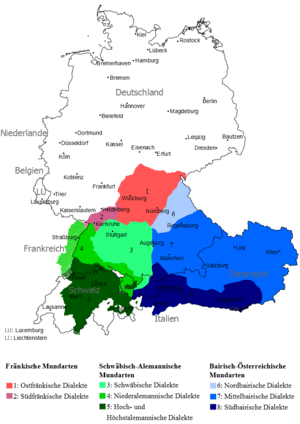Upper German
| Upper German | |
|---|---|
| Geographic distribution: | Southern Germany, northern and central Switzerland, Austria, Liechtenstein, Northern Italy (South Tyrol), France (Alsace) |
| Linguistic classification: |
|
| Subdivisions: | |
| Glottolog: | uppe1397[1] |
|
| |
Upper German (German: ![]() Oberdeutsch ) is a family of High German dialects spoken primarily in the southern German-speaking area (Sprachraum).
Oberdeutsch ) is a family of High German dialects spoken primarily in the southern German-speaking area (Sprachraum).
Family tree
Upper German proper can be generally classified as Alemannic or Bavarian. However, the High Franconian dialects of the Franconian language, spoken up to the Speyer line isogloss in the north, are also considered part of the larger Upper German dialect group. Whether they should be included as part of Upper German or instead classified as Central German is an open question, as they have traits of both Upper and Central German and are frequently described as a transitional zone. Hence, either scheme can be encountered. Erzgebirgisch, usually lumped in with Upper Saxon on geographical grounds, is closer to East Franconian linguistically, especially the western dialects of Erzgebirgisch.
- Alemannic (German: Alemannisch, spoken in the German state of Baden-Württemberg, in the Bavarian region of Swabia, in Switzerland, Liechtenstein, the Austrian state of Vorarlberg and in Alsace, France)
- Swabian (Schwäbisch, spoken mostly in Swabia)
- Low Alemannic (Niederalemannisch)
- Alsatian (Elsässisch, spoken in Alsace, France, numbered 5)
- Alemán Coloniero, spoken in Colonia Tovar, Venezuela)
- Basel German (Baseldytsch), Basel German: Baslerdüütsch, German: Baseldeutsch)
- High Alemannic (Hochalemannisch)
- Bernese German (Bernese: Bärndütsch, German: Berndeutsch)
- Zurich German (Zurich German: Züritüütsch, German: Zürichdeutsch)
- Highest Alemannic (Höchstalemannisch)
- Walser German (Walserdeutsch) or Walliser German (Walliser German: Wallisertitsch, German: Walliserdeutsch spoken in the Wallis Canton of Switzerland)
- Bavarian (Bavarian: Boarische Språch, German: Bairisch, spoken in the German state of Bavaria, in Austria, and in South Tyrol, Italy
- Northern Bavarian (Bavarian: Nordboarisch, German: Nordbairisch, spoken mainly in the Bavarian Upper Palatinate region, numbered 6)
- Central Bavarian (Bavarian: Mittelboarisch, German: Mittelbairisch, spoken mainly in Upper and Lower Bavaria, in Salzburg, Upper and Lower Austria)
- Viennese German (German: Wienerisch, spoken in Vienna and parts of Lower Austria)
- Southern Bavarian (Bavarian: Südboarisch, German: Südbairisch, spoken mainly in the Austrian states of Tyrol, Carinthia and Styria, as well as in South Tyrol, Italy)
- Gottscheerish or Granish (Gottscheerish: Göttscheabarisch, German: Gottscheerisch, Slovene: kočevarščina, spoken in Gottschee, Slovenia, nearly extinct)
- Cimbrian (Cimbrian: Zimbar, German: Tzimbrisch, Italian: Italian: lingua cimbra, spoken in the Seven Communities (formerly also in the Thirteen Communities) in Veneto, and around Luserna (Lusern), Trentino, Italy)
- Mòcheno language (Mòcheno: Bersntoler sproch, Italian: lingua mòchena, German: Fersentalerisch, spoken in the Mocheni Valley, Trentino in Italy)
- Hutterite German (German: Hutterisch, spoken in Canada and the United States)
- High Franconian (German: Hochfränkisch, spoken in the Bavarian Franconia region, as well as in the adjacent regions of northern Baden-Württemberg and southern Thuringia)
- East Franconian (German: Ostfränkisch, colloquially just Fränkisch)
- Main-Franconian (German: Mainfränkisch, mainly spoken in Bavarian Franconia, in the adjacent Main-Tauber-Kreis of Baden-Württemberg, as well as in Thuringia south of the Rennsteig ridge in the Thuringian Forest)
- Itzgründish (German: Itzgründisch, spoken in the Itz Valley)
- Vogtlandish (German: Vogtländisch, spoken in Vogtland, Saxony
- Main-Franconian (German: Mainfränkisch, mainly spoken in Bavarian Franconia, in the adjacent Main-Tauber-Kreis of Baden-Württemberg, as well as in Thuringia south of the Rennsteig ridge in the Thuringian Forest)
- South Franconian (German: Südfränkisch, spoken in the Heilbronn-Franken region of northern Baden-Württemberg down to the Karlsruhe district.
- East Franconian (German: Ostfränkisch, colloquially just Fränkisch)
Lombardic
Based on the fact that Langobardic, extinct around 1000, has undergone the High German consonant shift completely, it is also often classified as Upper German. However, if the High German consonant shift occurred late (7th/8th century), which now seems to be the prevalent view, it would seem to be anachronistic to do so.
On the other hand, if Langobardic was still essentially identical to Bavarian or Alemannic at the time, the anachronism would disappear, and in fact, what is attested in Langobardic cannot really be shown to be systematically different in any particular point from the earliest attested form of Bavarian in the 8th century, apart from a few rather minor divergent phonological developments, which, however, seem to postdate the sound shift.
References
- ↑ Hammarström, Harald; Forkel, Robert; Haspelmath, Martin; Bank, Sebastian, eds. (2016). "Upper German". Glottolog 2.7. Jena: Max Planck Institute for the Science of Human History.
